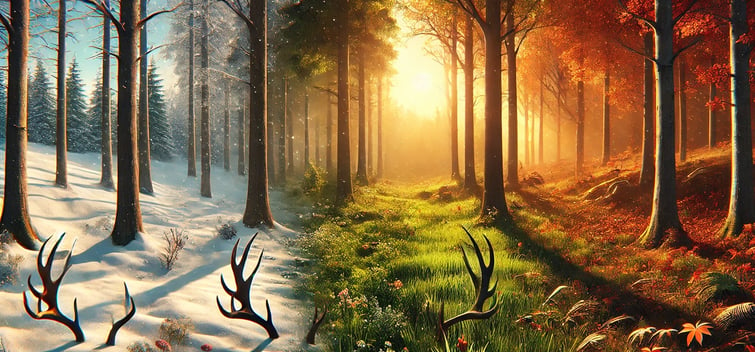Shed Hunting Tip #1 - Best Time to Hunt Sheds
3 min read


Late March is Prime Shed Hunting Season: The Best Time to Find Deer Sheds by Time Zoneontent
Late March marks the height of shed hunting season across the United States. Every year, deer naturally shed their antlers in late winter and early spring, leaving behind “white gold” for outdoorsmen to find.
Timing is everything when it comes to shed hunting. Go too early and many bucks may still be carrying their racks; go too late and you risk others (or rodents) beating you to those antlers. Fortunately, when to look for deer sheds is right now for most of the country – the conditions are perfect and the antlers are on the ground.
Here’s a breakdown of the best shed hunting timing by U.S. time zones (Eastern, Central, Mountain, Pacific), plus why timing matters and how to take advantage of current conditions.
🕰️ Why Timing Matters for Shed Hunting Season
Deer drop their antlers shortly after the rut each year, once falling testosterone levels signal the antler bones to separate. This antler cast can happen over a broad window from late December through March (and occasionally into April) depending on the region.
Factors like daylight, winter severity, nutrition, and the buck’s age or health all influence exactly when a given deer sheds. That’s why shed hunting season doesn’t have a one-size-fits-all date – it varies by region and even year to year.
In northern areas with harsh winters, deer often shed earlier (to conserve energy), whereas in milder climates or where the rut runs late, bucks may carry antlers longer into spring.
If you wait too long, sun, weather, and gnawing critters can deteriorate the sheds. By timing it just right, you’ll maximize your chances to find shed antlers in pristine condition while minimizing disturbance to deer during recovery.
🧭 Eastern Time Zone – Early Spring Antler Drops
In Eastern states, deer are well into their shed cycle by late March. Bucks in the Northeast (like New York and Pennsylvania) often begin shedding in December, with most antlers cast by early February. In the Southeast, some bucks don’t shed until March, and a few may carry antlers into early April.
Generally speaking, shed hunting season for the Eastern U.S. peaks in late winter and early spring. By late March, the majority of bucks have dropped their racks. This makes it an ideal time to check bedding areas, field edges, and travel corridors without disturbing antlered bucks.
🌾 Central Time Zone – Peak Shed Hunting Window
In the Central zone—covering the Midwest and parts of the South—shed hunting season is in full swing as March winds down.
In the colder northern parts (like Minnesota, Wisconsin, and Iowa), many bucks shed by late January or early February. In southern areas (like Missouri, Texas, or Kentucky), antlers tend to drop a few weeks later.
By the end of March, the sweet spot has arrived. You’ve got improving weather and visibility, deer have dropped, and vegetation hasn’t taken over. Check crop fields, fence crossings, and wood edges—this is prime time.
🏔️ Mountain Time Zone – Late Winter to Early Spring Drops
In the Mountain time zone (Colorado, Wyoming, Montana, Idaho), shed hunting season arrives as winter loosens its grip.
Mule deer and whitetail bucks often shed between mid-December and late March. Higher-elevation herds with tough winters shed earlier, while lower elevation deer may hang on to antlers until spring.
By late March, the great majority of deer have shed. This is the best time to explore winter ranges, trail systems, and southern-facing slopes before new growth covers the antlers.
Be sure to check for local regulations—some western states have shed hunting season restrictions to protect wildlife until winter is fully over.
🌲 Pacific Time Zone – Milder Climates, Spring Finds
The Pacific states (California, Oregon, Washington, and parts of Nevada) usually see deer shed their antlers from January through March.
Because winters are milder, blacktail and mule deer sometimes hold onto their antlers longer than deer in colder zones. Still, by late March, antler drops are well underway.
Thanks to minimal snow, you can often hike year-round here. Now is a great time to walk meadows, clear-cuts, oak flats, and coastal hills before spring greenery makes sheds harder to spot.
🏹 Make the Most of the Season
No matter where you live, late March is a golden opportunity for shed hunters. By this point in the season, the majority of bucks have dropped their antlers, and the ground is ready to be searched.
New vegetation hasn’t fully come in yet, the weather is improving, and deer are past the most vulnerable part of winter. That makes this moment ideal—not just for your success, but for the well-being of the wildlife.
So lace up your boots, pack some snacks, bring a friend or a dog, and get out into the woods or fields. Shed hunting season is short—and this is one of the best weekends of the year to find those antlers.
